Select your city
Language
The Yucatan Peninsula offers snorkelers an abundance of great locations that can meet the demand of experienced divers taking a break and beginners visiting the coral for the first time.
If snorkeling is a primary focus of your trip then it pays to know where to go before you even book your hotel.
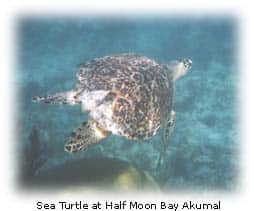
We recommend taking your own equipment as well [mask, snorkel, fins] although there are shops almost everywhere there is good snorkeling selling gear including replacement parts to repair broken fin-straps etc.
Nearly all hotels have equipment on hand but our experience is that the masks leak most of the time and we question the sanitation of using a snorkel other people have been biting on.
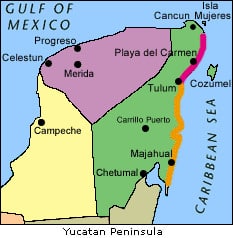
STATES
 Yucatan
Yucatan Campeche
Campeche Quintana Roo
Quintana RooCOASTAL REGIONS
 Mayan Riviera
Mayan Riviera Costa Maya
Costa MayaThe Mexican name for the Atlantic coastal region of the Yucatan Peninsula is “Riviera Maya”. The English use is either Mayan Riviera or Maya Riviera. It is used all three ways in this web site.
Isla Mujeres is a great place to stay for divers and there are excellent beaches here. The currents can be pretty strong on the south side so snorkeling can be a bit more of a challenging swim than a pleasant snorkel.
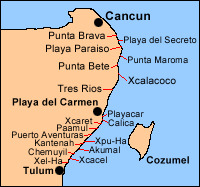
We ran into a school of barracudas on the south side once, which was extremely exhilarating! Garrafón Park is located on the far east side of the island and is the place to snorkel here.
Isla Mujeres – Snorkeling & Diving
Isla Holbox does not have any coral reefs and the gulf seabed is basically seaweed, branch coral, and sand/clay. Visibility is 10 – 15 ft. on a good day. People come here to swim and snorkel with Whale Sharks, the world’s biggest fish. You need to take a tour to do this. Due to government restrictions; Scuba Diving with the Whale Sharks is prohibited.
For more info see: Isla Holbox Swim With Whale Sharks
Cancun is not the place to go for snorkeling. The waves make it too rough and the seabed is sand and dead coral. Great beaches for beach lovers but not good for snorkelers.
The Mayan Riviera [Riviera Maya] is the place to go if you are looking to snorkel. Primarily, Akumal is the area you want to stay in for the best snorkeling.
For more info see: Snorkeling The Mayan Riviera
Cozumel is a diver’s paradise and is known for just this, the world over. Snorkeling on the west side is great but the current can be strong. Best to take tours and go out in a boat to some of the choice locations that the guides know. Here, when the current pushes you along the boat can pick you up.
For more info see: Cozumel Snorkeling
Snorkeling around Majahual is good but going out on a boat is better. We find the coastline sandy with lots of sea grass. We had the opportunity to bump into a school of dolphins once about 25 miles out. This was amazing.
Probably the best places to take children snorkeling is either Xel-Ha or Yal Ku Lagoon . Xel-Ha provides the snorkeling gear and life jackets must be worn by all.
Xel-Ha is an Eco park with excellent food services and numerous lifeguards on duty at all time. We have seen sea turtles, stingrays, sea-horses and LOTS of other marine wildlife snorkeling there. It is a great place to spend the day for all ages.
You can take a tour that includes Xel-Ha or you can take a taxi or colectivo to get there.
Another interesting thing about Xel-Ha is that Xel-Ha ruins are located a short walk south on the highway from the main entrance to the Eco Park. This ruin site is unique amongst Mayan ruin sites because it has a cenote with a sweat lodge still intact.
The principle occupation of the Mayans who once lived there appears to be the harvesting of conch shells to be crushed and burnt to create an ingredient for mortar used in building. When the Maya lived there it is likely that the only trees left standing were there for fruit bearing.
During the period that the small city flourished it is conceivable that there was a great demand for their product with the probability that much of it went inland carried on small tributaries that opened up after the rainy season each year.
Snorkeling depends largely on wind speed. Wind affects the sea contributing to the wave action. When the waves reach a certain height it is impossible to snorkel. In fact it makes it difficult for divers too, because the boats cannot go out either.
It is our opinion [backed up by statistics] that September is the best month to snorkel the Mayan Riviera with the period of July – January to be the best “window” to go, if snorkeling is high on your list of things to do.
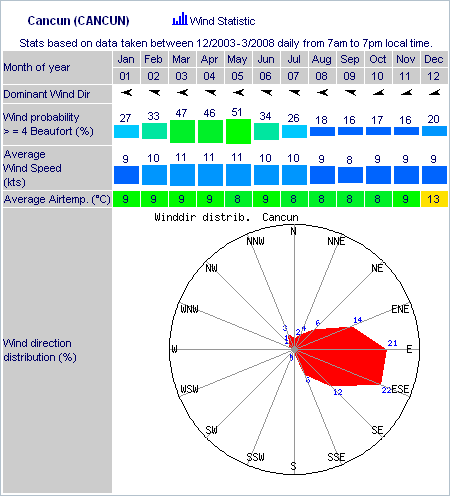
Windspeed table for Conversion of Knots – km/h
| Knots | km/h | Label | Effect on sea |
| 1 | 1 | Calm | Sea like a mirror |
| 1-3 | 1-5 | Light Air | Ripples with the appearance of scales are formed, but without foam crests |
| 4-6 | 6-11 | Light Breeze | Small wavelets, still short, but more pronounced. Crests have a glassy appearance and do not break |
| 7-10 | 12-19 | Gentle Breeze | Large wavelets. Crests begin to break. Foam of glassy appearance. Perhaps scattered white horses |
| 11-15 | 20-28 | Moderate Breeze | Small waves, becoming larger; fairly frequent white horses |
| 16-21 | 29-38 | Fresh Breeze | Moderate waves, taking a more pronounced long form; many white horses are formed. Chance of some spray |
| 22-27 | 39-49 | strong Breeze | Large waves begin to form; the white foam crests are more extensive everywhere. Probably some spray |
| 28-33 | 50-61 | Near Gale | Sea heaps up and white foam from breaking waves begins to be blown in streaks along the direction of the wind |
| 34-40 | 62-74 | Gale | Moderately high waves of greater length; edges of crests begin to break into spindrift. The foam is blown in well-marked streaks along the direction of the wind |
| 41-47 | 75-88 | Severe Gale | High waves. Dense streaks of foam along the direction of the wind. Crests of waves begin to topple, tumble and roll over. Spray may affect visibility |
| 48-55 | 89-102 | Storm | Very high waves with long over-hanging crests. The resulting foam, in great patches, is blown in dense white streaks along the direction of the wind. On the whole the surface of the sea takes on a white appearance. The ‘tumbling’ of the sea becomes heavy and shock-like. Visibility affected |
| 56-63 | 103-117 | Violent Storm | Exceptionally high waves (small and medium-size ships might disappear behind the waves). The sea is completely covered with long white patches of foam flying along the direction of the wind. Everywhere the edges of the wave crests are blown into froth. Visibility affected |
| 64-71 | 118-133 | Hurricane | The air is filled with foam and spray. Sea completely white with driving spray; visibility very seriously affected |
| Abbreviation | wind direction | Degrees |
|---|---|---|
| N | North | 0° |
| NNE | NorthNorthEast | 22.5° |
| NE | NorthEast | 45° |
| ENE | EastNorthEast | 67.5° |
| E | East | 90° |
| ESE | EastSouthEast | 112.5° |
| SE | SouthEast | 135° |
| SSE | SouthSouthEast | 157.5° |
| S | South | 180° |
| SSW | SouthSouthwest | 202.5° |
| SW | Southwest | 225° |
| WSW | WestSouthwest | 247.5° |
| W | West | 270° |
| WNW | WestNorthwest | 292.5° |
| NW | Northwest | 315° |
| NNW | NorthNorthwest | 337.5° |
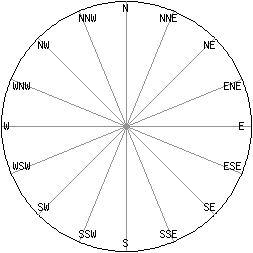
You just never know. One day the waves can be a meter high the next day the water is still. You have to be prepared to snorkel whenever the water is good. You can’t assume that the sea will be calm all day because it is calm in the morning.
On a sunny day in the summer you will have good light up until 5:00 gradually diminishing to 4:00 at the end of September.
If the sea has been very wavy for any length of time [weeks] then visibility will be dramatically reduced due to the amount of sediment in the water.
What makes Cozumel so attractive for diving is that the western side of the island is protected and water conditions are usually great. This makes the island a great place to snorkel as well and there are numerous guides with boats available to take you to some choice locations. Trips run from $20.00 – $50.00 depending on where you go and how long you go out.
All coastal property is controlled by the Mexican Federal Government and is open to all people. You are free to snorkel the waters of any beach you wish. The problem is that highway 307 runs around a km away from the coast in some spots and access points are few and far apart. What you will see is a number of resorts and small roads cut into the forest. Some of these roads are private, many are for beaches, restaurants and cabanas. Look for signs indicating beach, diving, fishing and cabanas.
We have been told [unofficially] that access to any beach must be given upon request by an individual through a resort property. However resort gate guards have told us that we would have to pay a fee to use their beach. The law does prohibit people from trespassing through private property so technically you must first gain permission to cross someone’s property however once on the beach they have no legal authority over you.
All resorts have snorkel equipment to lend you. It has been our experience however that every mask we have ever borrowed, leaked water to the point of being useless.
You can buy equipment on the Riviera in any number of dive shops. Many resorts even sell equipment. Equipment at the dive shops is priced according to the U.S. market so expect to pay U.S. prices for everything. Most shops carry top quality equipment.
Some attractions like Xcaret and Xel-Ha provide new snorkels and they have enough masks that you can usually find one that won’t leak. They also carry fins and life jackets, which are mandatory.
While snorkeling you may encounter a 5-ft barracuda. They are ferocious looking creatures with lots of teeth. They are also a very curious fish and may approach you. If you see one it is best to slowly swim away. If he starts following you don’t panic, just continue to swim. If he swims right up to you do not make any sudden moves. Hold your ground and gently swim away.

Barracudas are attracted to shiny objects and can be found in quite shallow water. They will just sit there in one spot while the water flows past them. You can swim quite close to one and they will not flinch. Actual barracuda attacks are extremely rare and are attributed mostly to spear fisherman.
If you have ever seen the film footage of “Captain Bob Olson” being attacked by a barracuda the footage is rather gruesome. It was also staged for the cameras and was totally faked.
Once a mask has been damaged it will leak. Damaging occurs from masks not being cleaned, sand/debris particles scraping the insides, men’s facial stubble and age.
Men should shave before snorkeling. You can also create a “seal” by applying Vaseline or silicone grease to your face. You can also buy a mask with a “Purge Valve”, which is a small one-way valve that allows water to drain out of the mask.
If your mask leaks then it needs replacing.
Always clean masks after you have snorkeled. You must clean the sea-salt off the mask.
Want to swim faster with less effort? Use diver’s ankle weights.
Weights pull left leg down providing thrust with minimum effort.
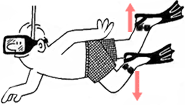
Use buoyancy to raise right leg. Repeat, alternating legs.
Using ankle weights reduces the energy needed to swim and can extend your snorkel time by conserving energy.
Wear a snorkel vest or shirt. They are made from water resistant neoprene. Not to be confused with Life Vests.
Even a T-shirt will work. Wearing a vest/shirt will help you conserve heat and keep your back from getting sun burnt. If you happen to get washed into some coral or rocks it can also protect you. These items can be found at dive shops.
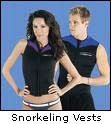
It is best to put your gear on in the water. Don’t put it all on and try to walk across the beach and into the water.
First look for a safe place to enter the water. Hold your mask/snorkel in one hand and your fins in the other [put hands through straps to hold securely].
Enter the water up to around waist height. Dunk your head into the water to get your hair/face wet. Put your mask/snorkel on. Now, while in the water you can safely wade to put your fins on.
Never assume that boats, kayaks, sea-doos can see you and know you are there. If a watercraft is headed in your direction keep your eyes on it and warn any other snorkelers in the vicinity. Wave your arms if you have to, to get the drivers attention. Be prepared to take evasive maneuvers if you have to.
Most resorts have boating lanes roped off or have the safe swimming/snorkeling section of the water roped off for your safety.